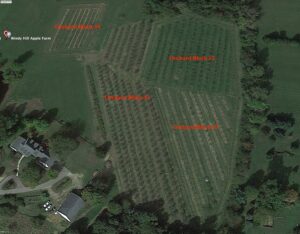Project Overview
Information Products
Commodities
- Fruits: apples
Practices
- Crop Production: foliar feeding, nutrient management
- Education and Training: demonstration, extension, farmer to farmer, mentoring, networking, on-farm/ranch research, technical assistance
- Farm Business Management: budgets/cost and returns, farmers' markets/farm stands, feasibility study, financial management, marketing management
- Natural Resources/Environment: biodiversity, drift/runoff buffers
- Pest Management: biological control, cultural control, field monitoring/scouting, integrated pest management, prevention
- Production Systems: organic agriculture
- Soil Management: organic matter, soil analysis, soil microbiology, soil quality/health
- Sustainable Communities: local and regional food systems, partnerships, public policy, quality of life, social capital, social networks
Summary:
Beginning in 2021, we noticed that a majority of our trees were losing their leaves and by mid-September some trees were defoliated. Through personal research, support from Ohio State Extension, and contact with the orchard manager at the Rodale Institute, we learned the issue was an emergent disease, Marssonina leaf blotch (MLB). Moreover, we learned that MLB almost exclusively affects organic orchards as commercial orchards’ use of fungicides offer protection against the disease. In the 2022 season, we had almost complete decimation of our operation due to the presence of MLB, with our trees completely defoliated by the first week of September. It is important to note that 2022 had above average rainfall from spring to early summer, which likely exacerbated the presence of MLB.
MLB is a serious threat to the viability of organic apple operations. The purpose of this application is to study viable cultural and/or treatments organic growers can use to combat this new devastating disease within Ohio. If organic controls or new cultural practices are not found to be viable in preventing MLB and its resulting defoliation, we will have to drop our organic certification and use conventional fungicides to address the issue.
Project objectives:
SOLUTION
Orchard Block #3 will serve as the control for our project, while Blocks #1, #2, and #4 will receive the intensive sulfur treatment which is the focus of our project. This decision was made due to Block #3 allowing for contrast by apple variety and root stock types. Our four orchard blocks can be seen in the attached image.
Control Block #3
In Block #3 will use management strategies that represent our farm standards as well as the suggested management strategies from organic orchardists in the region for addressing MLB. These strategies includes:
(1) the use of a flail mower beginning in early winter while trees dormant to promote the degradation of MLB. Flail mowers have been shown to be an effective orchard floor sanitation strategy (Cornell Cooperative Extension 2019).
(2) The application of oxidate 2.0 during tree dormancy on trunks, lower limbs, and orchard floor.
(3) Three spray applications of sulfur (Microthiol Disperss) before, during, and after blossom.
Treatment Blocks #1, #2, #4
In Blocks #1, #2, and #4 we will test a more intensive sulfur spray program relative to the farm standard for controlling MLB. In the treatment blocks we will use the same farm standard management strategies as our control block, but we will use intensive spray applications of sulfur at concentrations of 10 lbs/acre and intervals of 7-10 days across the three treatment blocks.
Tracking Efficacy of Treatment
We will compare the MLB damage between the same varieties and root stock types in each orchard block. We will measure the degree of damage for both the foliage as well as the crop quality.
For the degree of foliage damage, we will use a simple scale of 4 degrees of damage:
- Leaves fairly clean of spots
- Leaf spots, minimal defoliation
- Leaf spots with some areas of defoliation
- Severe defoliation of tree
To track the foliage damage, we will survey each orchard block weekly from June to September; this is the key time period in which MLB spores have been detected and symptom development has occurred (Khodadadi et al. 2022). In our final report, we will use these measurements to calculate the percent damage detected across orchard blocks by variety and root stock type. Collecting data across two seasons we will enable us to track seasonal progress in reducing the presence of MLB. This will enable us to see if there is any possible correlation between the pedigree and vulnerability of varieties to MLB.
To measure the quality of crop, Brix level readings will be taken from June to post-harvest. Brix level readings typically fall within 11 to 18 percent sugar content. We will use this as a baseline to evaluate the development and quality of the apples during the growing season and post-harvest. Additionally, we will evaluate crop quality by documenting the apple size and number of apples per bushel post-harvest. In recent years, MLB has resulted in significantly smaller apples and therefore requires more apples per bushel.
OBJECTIVES
- Identify cultural and/or organic control strategies for mitigating damage from Marssonina leaf blotch in organic apple production in Central Ohio.
- Evaluate the efficacy of intensive sulfur treatments in reducing infestation of Marssonina leaf blotch.
- Share findings with regional producers. We will invite managers from orchards within the region, contacts from Ohio State Extension, as well as farm educators from our regional organic certifier, Ohio Ecological Food and Farm Association (OEFFA). Additionally, we will share our project progress through our website and social media updates. We will report on findings at local producer conferences, such as the annual meeting for OEFFA.
